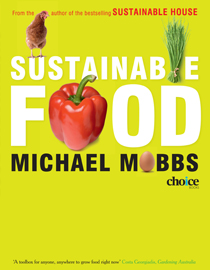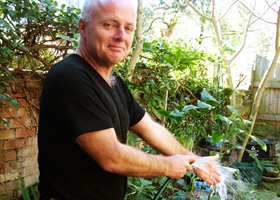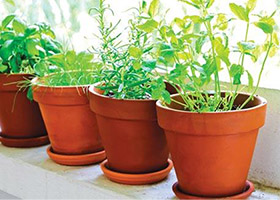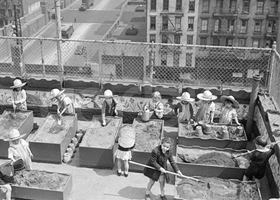Michael Mobbs on sustainable food 2
Author | Michael Mobbs
Environmental lawyer, consultant, urban farm designer and all round sustainability guru, Michael Mobbs attracted Australian and international attention when he converted his small inner city house into a water collecting, energy generating, waste water/sewage reusing residence. The following article is one of two extracts from Michael Mobbs’ new book, Sustainable Food.
‘Sustainable food’ is local, homegrown and I can walk to get it.
My book Sustainable Food is about how and why to grow and buy food this way. It’s not about the ‘isms’ or doctrines or fashions of food and the debates about it. Thus, there’s little discussion of issues such as industrial agriculture, genetically modified food, ‘double digging’, biodynamic farming or permaculture. These are acknowledged and briefly explained. In ‘Further reading’ you’ll find a detailed list of books and websites which provide fuller accounts.
I’m just beginning to call myself a ‘gardener’.
When I re-did the house [Mobbs’ fully environmentally sustainable terrace house in Chippendale, Sydney] I was motivated partly because engineers and others said I couldn’t do it. I knew otherwise because that’s what we’d done on our family farm. And now, I’m gardening this way, in the streets, partly for the same reason; we grew food on the farm. A majority of people, called ‘experts’ or ‘professionals’, who design and build our cities don’t think, and aren’t trained, to give advice that it’s important to grow food here in our suburbs and cities, but it is, vitally. And many people, experts, professionals and others say it can’t be done, so a bunch of us are doing it.
I’m concerned that – perhaps in the next 10 years – my local shops and supermarkets may not be able to supply the food I need. I’m increasing my food supply options, and expanding the food options of my community too.
The things that secure our culture – water, soil, food and energy – are becoming increasingly fragile. Due in part to increasing, dramatic weather changes it’s getting harder to grow food here and overseas. Widening political instability and declining amounts of oil to grow and transport supermarket food is, and should be of great concern to us, particularly those who assert the right to ‘govern’ us or design our cities, but it isn’t. So I’m gardening to grow food as if my life depends on it. The most convincing argument, the most compelling set of facts, is a garden which anyone may see, experience, smell and touch, and see others using. Gardening gives me hope.
This book provides a map for communities to grow, buy, cook and re-use wasted food to sustain themselves, based on our experiences in Chippendale and in other communities. It describes my household garden, the garden in my local park and how my neighbours and I garden on our roadside verges along 20 city blocks. Governments can learn from what our communities do, and the book is for them, too; I hope they read it with a view to a shared vision for our culture – it’s in our interests for any of us of any age to question, trial, test and play with the best ways to grow food.
The book goes into some detail about indigenous and exotic plants and connections I’ve made with Aboriginal elders and therefore the heritage of our land and its traditional peoples. It looks at bees and chickens, insects and organisms too, those things that form part of the Earth’s food systems, not just us humans.
Local councils own about a quarter of the land in our cities. And at least another 12 government agencies and private companies also have legal powers to do works in the streets. They are custodians of this land, so their role is important. So if you want to do what we’ve done you’ll find the solutions for negotiating the use of this land within its pages.
In the years 2008 to 2012 our community trialled a range of sustainable options and technologies in the suburb of Chippendale. Prompted by the support for these works the council commissioined me to prepare a plan to make the whole suburb sustainable, calling it the ‘Sustainable Communities Plan’ (also known as the ‘Chippendale Plan’). It seeks to combine most of the things we need to do to achieve a self-repairing city. Once it’s in force it will, I hope, be copied by other councils too. Much of the plan is in this book too and it may be the first of its kind.
It applies to all the land here, including the roads and transport. It also deals with the buildings and food. The plan shows how, for not much money, we may change roads to places where the car is a guest, the citizen may talk, walk and bicycle safely, and we may garden as we did a hundred years ago and for thousands of years before that.
The plan offers practical, affordable solutions to the problems identified in this book. It will sustain our water, sewage, energy and materials. It invites communities to take action with financial incentives that may be used to sustain a suburb. The plan gives rate rebates for composting, cutting waste, gardening in public land – including roads – and for making a commercial or residential building sustainable. It gives design options for cooling our cities, cutting down our energy use and bills and cutting our air pollution.
If households and businesses with a small back lane wish to close it off at weekends for BBQs, gardening and for children to play, the plan gives a simple self-regulating pre-approval process for $0 cost. It gives priority to sustainable over unsustainable development. It’s free.
Delegations from China have visited Chippendale to inspect the area and to enquire about the plan’s suitability for cities in their country. Some Australian councils are taking up some of the plan’s ideas. You can see the whole plan here.

What we’ve achieved in our Chippendale road gardens
In the four years we’ve been gardening in the roads we’ve:
- kept four million litres of water on road gardens for less than $300;
- watered about 500 square metres of gardens along footpaths by rainfall from the front roofs of houses;
- created rain harvesting roofs with a combined area (2500 square metres plus street gardens some 1200 square metres), a total of 3700 square metres. Each year each square metre of that area will receive over 1200 litres of rainwater. Each year we save over 4.4 million litres of water from being wasted and polluting Sydney Harbour.
- Over the first two years of planting and upkeep the estimated cost to residents and businesses has been about $4500. All up businesses have given over $30,000.
These are small figures. But because they’ve triggered so much media, so much opportunity for teaching bodies to inspect and pass on the ideas, so many people visit here or look on the web and have begun their own road and community garden projects, it’s clear that these little achievements have an impact far beyond their immediate dimensions. Some TAFEs are now offering ‘urban farming’ courses.
Beyond these water and pollution savings we’re also supporting the smallest critters of our suburb. In 2008 we started with hostile earth in the street verges with no worms or bugs to be seen. But the soil is slowly coming to life with our rich compost, and with the mulch that we buy or is given to us by council. We’re providing a habitat for small soil-bound creatures and the soil is holding valuable moisture during the hot summer months. The trees all struggle, native and edible, particularly in the city-made heat, but we’re making progress, even if it seems too slow at times. The 100 or so of us involved in this project expect that in another few years, our soil will be rich enough to grow more produce for our meals.
In the meantime, a few of us have committed to buying the rest from our farmers and from commercial urban farms as they develop in the inner city; just 100 or so out of a total population of 4000 residents.
Water needed to produce a modest meal
47 litres medium sized tomato
400 litres small punnet of yoghurt
80 litres commercial egg (includes the water to grow the grain, feed
the chook, clean, transport and store the egg)
87 litres slice of commercial bread
Add bacon and you’ll reach a thousand litres just for that meal! And we eat three meals a day …
If you wish to calculate your water footprint – the water used to live – one of the most comprehensive calculators is offered by the Centre for Integrated Sustainability Analysis at the University of Sydney. It includes much of what we consume that needs water and energy; for example, food, housing, mobility, goods – like clothing, shoes, TVs – and services.
Another good resource is the Australian Conservation Foundation’s Australian Consumption Atlas. This allows you to enter your postcode and see what water, energy or resources are used by people and businesses in your suburb. At my postcode, 2008, the average water use is 750,000 litres per person.

Michael Mobbs’ new book Sustainable Food is published by Choice Books [Nov 2012], rrp $45.






